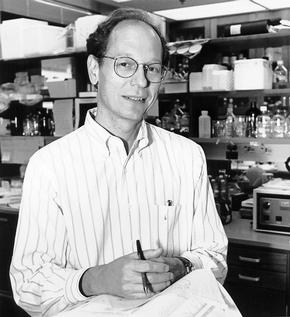
Dr. Thomas Quertermous is studying blood vessel development to fight vascular disease.
Researcher seeks genetic edge to fight vascular disease
A VUMC researcher is searching for a way to use the fundamental process of blood vessel development as a weapon in the fight against vascular disease.
"If we could manipulate this process we could grow new blood vessels or inhibit the growth of blood vessels. We could approach in a therapeutic fashion a vast array of different disease functions," said Dr. Thomas Quertermous, professor of Medicine and chief of Cardiology.
Abnormal blood vessels, found in such severe health events as heart attacks, brain tumors and strokes, are directly linked to some of the leading causes of death in America.
The process responsible for the formation of blood vessels is called angiogenesis. In recent years the potential for controlling angiogenesis has come under scrutiny. If doctors could control and harness the complex process, therapeutic treatments could once day be developed that could possibly put an end to many vascular diseases.
Quertermous has begun to determine the possibilities of disease treatment through cell manipulation. His research focuses on the role of endothelial cells on angiogenesis. Endothelial cells line the inside of large blood vessels and serve as the only cells which make up the capillaries, the smallest vascular structures.
New blood vessels are created when the normally hibernating endothelial cells bud and branch off of existing cells. If endothelial cells make too many blood vessels, tumors or cancer can develop. If endothelial cells make too few blood vessels, events such as heart attacks and strokes can occur.
"I'm interested in the fundamental process of how the endothelial cell talks to its brothers and decides to form a new blood vessel," said Quertermous.
The goal is to be able to slow down the process of angiogenesis or speed it up, depending on the type of vascular problem.
First, however, Quertermous must characterize new genes which are expressed in the endothelial cells that are forming blood vessels. His approach is to identify genes that play a role in the embryo, where vascular development is rapid and well organized. Once these genes are characterized, Quertermous hopes that they can be applied to models of adult angiogenesis.
In order to study angiogenesis Quertermous has teamed up with Progenitor, a pharmaceutical company, to find the genes responsible for endothelial cell communication.
"This is an unusual circumstance which really reflects the increasing focus on blood vessel development. There is an enormous amount of information that can be used down the road," said Quertermous.
The partnership will involve a biased search for genes in a specific type of cell at a specific point in angiogenesis. Instead of searching for genes involved in angiogenesis at any point and then sorting out the relevant ones, technology has allowed Quertermous to narrow the search parameters to the exact segment in angiogenesis he wants to investigate. Once Quertermous finds the genes, possible therapeutic applications can be investigated.
"We generally look for funding from the National Institutes for Health or the American Heart Association because private companies are generally more interested in the practical applications of research. It is refreshing to have a private company as a partner," said Quertermous.
The genomic project with Quertermous is one of only a few collaborative efforts that Progenitor funds.













